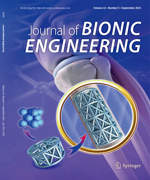|
|
Artificial Hair-Like Sensors Inspired from Nature: A Review
Zhiwu Han, Linpeng Liu, Kejun Wang, Honglie Song, Daobing Chen, Ze Wang, Shichao Niu,
Journal of Bionic Engineering. 2018, 15 (3):
409-434.
DOI: https://doi.org/10.1007/s42235-018-0033-9
Nature creatures have evolved excellent receptors, such as sensory hairs in arthropods, lateral line system of fishes. Researchers inspired by nature creatures have developed various mechanical sensors. Here, we provide an overview on the development of Artificial Hair-Like (AHL) sensors based on the inspiration of hair flow sensory receptors, especially sensory hairs in arthropods and lateral line systems of fishes. We classify the developed AHL sensors into several categories according to the operating principles they based on, for example, piezoresistive and piezoelectric effects. The current challenges and existing problems in the development of AHL sensors are also present, which were primarily restricted by the exploratory tools of sensing mechanism of creatures and current manufacturing technologies. In future, more efforts are required in order to further improve the performance of AHL sensors. We expect that intelligent multi-functional AHL sensors can be applied not only in applications like navigation of underwater automatic vehicles, underwater search and rescue, tap-water metering, air monitoring and even in medicare, but also potentially be used in space robots to detect complex to-pography.
Related Articles |
Metrics
|

 Table of Content
Table of Content
 Table of Content
Table of Content